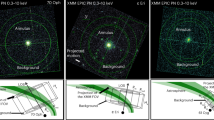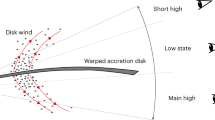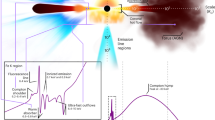Abstract
IN the eccentric-orbit binary model1,2, a compact object is in an eccentric orbit around a more massive, slightly evolved star. If the compact object accretes mass from the stellar wind of the normal star, the accretion rate is time dependent, so that the resulting X-ray emission would show a maximum at periastron (in the absence of absorption extinction) and a minimum at apastron. It is also possible that accretion might arise from direct mass transfer resulting from contraction of the Roche lobe with decreasing primary to secondary distance. We show here that the stellar wind model, is adequate to describe the majority of transient X-ray sources.
This is a preview of subscription content, access via your institution
Access options
Subscribe to this journal
Receive 51 print issues and online access
$199.00 per year
only $3.90 per issue
Buy this article
- Purchase on SpringerLink
- Instant access to full article PDF
Prices may be subject to local taxes which are calculated during checkout
Similar content being viewed by others
References
Clark, D. H., Parkinson, J. H., and Caswell, J. L., Nature, 254, 674–676 (1975).
Pacini, F., and Shapiro, S. L., Nature, 255, 618–619 (1975).
Gott, J. R., Astrophys. J., 173, 227–234 (1972).
Ives, J. C., Sanford, P. W., Bell-Burnell, S. J., Nature, 254, 578–580 (1975).
Brecher, K., Nature, 257, 203 (1975).
Ricketts, M. J., Pounds, K. A., and Turner, M. J. L., Nature, 257, 657–658 (1975).
Boley, F., and Wolfson, R., IAU Circ., No. 2819 (1975).
Clark, D. H., and Caswell, J. L., Mon. Not. R. astr. Soc. (in the press).
Lea, S., and Margon, B., Astrophys. Lett., 13, 33–37 (1973).
Kaluzienski, J. L., Holt, S. S., Boldt, E. A., Serlemitsos, P. J., Nature, 256, 633–634 (1975).
Fabian, A. C., Pringle, J. E., and Webbink, R. F., Nature, 255, 208 (1975).
Amnuel, P. R., Guseinov, O. H., and Rakhamimov, Sh., Jr, Astrophys. Space Sci., 29, 331–342 (1974).
Paczynski, B., A. Rev. Astr. Astrophys., 9, 183–208 (1971).
Tademaru, E., and Harrison, E. R., Nature, 254, 676–677 (1975).
Sutantyo, W., Astr. Astrophys., 41, 47–52 (1975).
Hulse, R. A., and Taylor, J. H., Astrophys. J., 195, L51–L53 (1975).
Davison, P. J. N., and Tuohy, I. R., Mon. Not. R. astr. Soc. (in the press).
Author information
Authors and Affiliations
Rights and permissions
About this article
Cite this article
CLARK, D., PARKINSON, J. Transient X-ray sources. Nature 258, 408–409 (1975). https://doi.org/10.1038/258408a0
Received:
Accepted:
Issue date:
DOI: https://doi.org/10.1038/258408a0
This article is cited by
-
GS2023+338: a new class of X-ray transient source?
Nature (1989)
-
The effect of the stellar wind velocity on the eccentric-orbit binary model
Astrophysics and Space Science (1982)
-
Recurrent X-ray outbursts from Aquila X-1
Nature (1977)
-
Critical accretion flow of gas onto compact stars
Astrophysics and Space Science (1977)
-
The eccentric-orbit binary model for the transient X-ray sources
Astrophysics and Space Science (1977)



